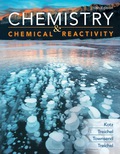
Chemistry & Chemical Reactivity
10th Edition
ISBN: 9781337670418
Author: Kotz
Publisher: Cengage
expand_more
expand_more
format_list_bulleted
Concept explainers
Question
Chapter 22, Problem 71GQ
Interpretation Introduction
Interpretation: The structure of three isomers has to be drawn and chirality has to be predicted.
Concept introduction:
Formula of coordination compounds: Formula of a coordination complex is able to predict by using the metal ion and ligands, and to derive the oxidation number of the coordinated metal ion.
Isomerism: Isomers are compounds with same molecular formula with different arrangements of atoms.
- Structural isomers: have same molecular formula but different bonding arrangements of atoms. It is classified into coordination isomer (occurs by exchanging a coordinated ligand and the counter-ions) and linkage isomers (ligand attached through different atoms to the metal).
- Stereoisomers: differ in their spatial arrangement of atoms.
Expert Solution & Answer
Want to see the full answer?
Check out a sample textbook solution
Students have asked these similar questions
A partir de Aluminio y Co(NO3)2ꞏ6H2O, indicar las reacciones a realizar para obtener Azul de Thenard (Al2CoO4).
To obtain Thenard Blue (Al2CoO4), the following reaction is correct (performed in an oven):Al(OH)3 + Co(OH)2 → Al2CoO4 + 4 H2O
Problem 38 can u explain and solve thanks april 24
Chapter 22 Solutions
Chemistry & Chemical Reactivity
Ch. 22.4 - (a) What is the formula of a complex ion composed...Ch. 22.4 - (a) Determine the metals oxidation number and...Ch. 22.4 - Name the following coordination compounds. (a)...Ch. 22.5 - What types of isomers are possible for the...Ch. 22.6 - Prob. 22.5CYUCh. 22.7 - Prob. 22.6CYUCh. 22.7 - Prob. 1.1ACPCh. 22.7 - Copper has a face-centered cubic unit cell. If...Ch. 22.7 - Prob. 1.3ACPCh. 22.7 - If a patient is given 10.0 mg of cisplatin, what...
Ch. 22.7 - Prob. 2.2ACPCh. 22.7 - How are the d electrons of Pt distributed in a...Ch. 22.7 - What are the electron configurations for Nd and...Ch. 22.7 - Prob. 3.2ACPCh. 22.7 - Prob. 3.3ACPCh. 22.7 - Prob. 3.4ACPCh. 22 - Identify, based on the position in the periodic...Ch. 22 - Prob. 2PSCh. 22 - Prob. 3PSCh. 22 - Prob. 4PSCh. 22 - Prob. 5PSCh. 22 - Iron is the most abundant transition element in...Ch. 22 - Prob. 7PSCh. 22 - Prob. 8PSCh. 22 - Prob. 9PSCh. 22 - Prob. 10PSCh. 22 - Identify a cation of a first series transition...Ch. 22 - Match up the isoelectronic ions on the following...Ch. 22 - The lanthanide contraction is given as an...Ch. 22 - Prob. 14PSCh. 22 - Prob. 15PSCh. 22 - Prob. 16PSCh. 22 - Prob. 17PSCh. 22 - Prob. 18PSCh. 22 - Which of the following ligands is expected to be...Ch. 22 - One of the following nitrogen compounds or ions is...Ch. 22 - Prob. 21PSCh. 22 - Prob. 22PSCh. 22 - Prob. 23PSCh. 22 - Prob. 24PSCh. 22 - Prob. 25PSCh. 22 - Prob. 26PSCh. 22 - Prob. 27PSCh. 22 - Prob. 28PSCh. 22 - Prob. 29PSCh. 22 - Prob. 30PSCh. 22 - Give the name or formula for each ion or compound,...Ch. 22 - Prob. 32PSCh. 22 - Prob. 33PSCh. 22 - Prob. 34PSCh. 22 - Prob. 35PSCh. 22 - Prob. 36PSCh. 22 - Prob. 37PSCh. 22 - Prob. 38PSCh. 22 - Prob. 39PSCh. 22 - Prob. 40PSCh. 22 - Prob. 41PSCh. 22 - Prob. 42PSCh. 22 - Prob. 43PSCh. 22 - Prob. 44PSCh. 22 - Prob. 45PSCh. 22 - Prob. 46PSCh. 22 - Prob. 47PSCh. 22 - Prob. 48PSCh. 22 - Prob. 49PSCh. 22 - Prob. 50PSCh. 22 - In water, the titanium(III) ion, [Ti(H2O)6]3+, has...Ch. 22 - Prob. 52PSCh. 22 - Prob. 53GQCh. 22 - Prob. 54GQCh. 22 - How many unpaired electrons are expected for...Ch. 22 - Prob. 56GQCh. 22 - Which of the following complex ions is (are)...Ch. 22 - Prob. 58GQCh. 22 - How many geometric isomers are possible for the...Ch. 22 - For a tetrahedral complex of a metal in the first...Ch. 22 - Prob. 61GQCh. 22 - Prob. 62GQCh. 22 - Prob. 63GQCh. 22 - A platinum-containing compound, known as Magnuss...Ch. 22 - Prob. 65GQCh. 22 - Prob. 66GQCh. 22 - Prob. 67GQCh. 22 - How many geometric isomers of the complex ion...Ch. 22 - Prob. 69GQCh. 22 - Prob. 70GQCh. 22 - Prob. 71GQCh. 22 - The square-planar complex Pt(en)Cl2 has chloride...Ch. 22 - The complex [Mn(H2O)6]2+ has five unpaired...Ch. 22 - Experiments show that K4[Cr(CN)6] is paramagnetic...Ch. 22 - Give a systematic name or the formula for the...Ch. 22 - When CrCI3 dissolves in water, three different...Ch. 22 - Prob. 77GQCh. 22 - The glycinate ion, H2NCH2CO2, formed by...Ch. 22 - Prob. 79GQCh. 22 - Nickel and palladium both form complexes of the...Ch. 22 - The transition metals form a class of compounds...Ch. 22 - Cerium, as noted in Applying Chemical Principles:...Ch. 22 - Prob. 84GQCh. 22 - Two different coordination compounds containing...Ch. 22 - Prob. 89SCQCh. 22 - Prob. 90SCQ
Knowledge Booster
Learn more about
Need a deep-dive on the concept behind this application? Look no further. Learn more about this topic, chemistry and related others by exploring similar questions and additional content below.Similar questions
arrow_back_ios
SEE MORE QUESTIONS
arrow_forward_ios
Recommended textbooks for you
 Chemistry: The Molecular ScienceChemistryISBN:9781285199047Author:John W. Moore, Conrad L. StanitskiPublisher:Cengage Learning
Chemistry: The Molecular ScienceChemistryISBN:9781285199047Author:John W. Moore, Conrad L. StanitskiPublisher:Cengage Learning

Chemistry: The Molecular Science
Chemistry
ISBN:9781285199047
Author:John W. Moore, Conrad L. Stanitski
Publisher:Cengage Learning